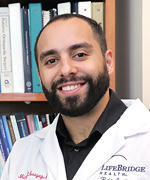Rickets
What is rickets?
Nutritional rickets is a childhood bone disease that causes weak bones and bone deformities. The disease is caused by children not getting enough vitamin D, which is critical for growing healthy bones. (There is also a rare, inherited form of rickets, called Vitamin D-resistant rickets or hypophosphatemic rickets.)
Rickets softens the ends of a child’s bones at the growth plates which can lead to bones growing crooked. Growth plates are located near each end of the humerus (upper arm bone), ulna/radius (lower arm bones), femur (thigh bone) and tibia (shin bone). They are composed of a thin (3 mm, 3/25 of an inch) layer of specialized cartilage. Growth plates are responsible for children’s arms and legs getting longer as they mature. Two of the most common bone deformities associated with rickets are bowlegs and knock knees.
What causes nutritional rickets?
Rickets is most often caused by prolonged and extreme vitamin D deficiency in a child’s diet. Other risk factors for children include:
- not getting enough sun exposure, (We make vitamin D in our skin when it is exposed to sunlight.)
- having dark skin, (Dark skin has more melanin pigment, which makes it harder for the skin to get enough sunlight to produce vitamin D.)
- having a condition that affects how a child’s body absorbs vitamin D (e.g., celiac disease, kidney issues, inflammatory bowel disease, and cystic fibrosis),
- being lactose intolerant, (Children that have restricted dairy intake are at higher risk.)
- having been breast-fed exclusively, (Breast milk does not have enough vitamin D to prevent rickets; vitamin D drop supplements are necessary.)
Vitamin D helps the body absorb calcium and phosphorous from the digestive track. Insufficient vitamin D makes it hard to keep adequate calcium and phosphorous levels in the bones. If the body does not absorb enough calcium, it will pull the calcium it needs from the bones, leaving them weak and more likely to break.
How is rickets diagnosed?
X-rays will often show bone fractures or breaks that have healed and bone deformities in arms or legs, such as bowlegs or knock knees. In children, the growth plates will be wider than normal, due to the poor mineralization of the growing bone. The doctor may also run blood tests to check levels of Vitamin D, calcium, and phosphorus.
How is nutritional rickets treated?
Although full recovery can take many months, Vitamin D and calcium supplements begin the healing process right away. Often, bone deformities from nutritional rickets can straighten themselves over time without surgery. In cases where children have severe bowlegs or knock knees, surgery may be necessary; please see those pages for how these conditions are treated. To learn more about the process of correcting bone deformities, please click here.
Why choose the International Center for Limb Lengthening for treatment of rickets?
Bone deformity correction is a complex process. Your doctor at the International Center for Limb Lengthening will take the time to make sure you understand all of your options and then will customize your treatment to meet your specific needs. Our patients benefit from our team-centered approach with world-renowned surgeons and specialized physician assistants, nurses and physical therapists. We help patients with rickets achieve their best possible result.


